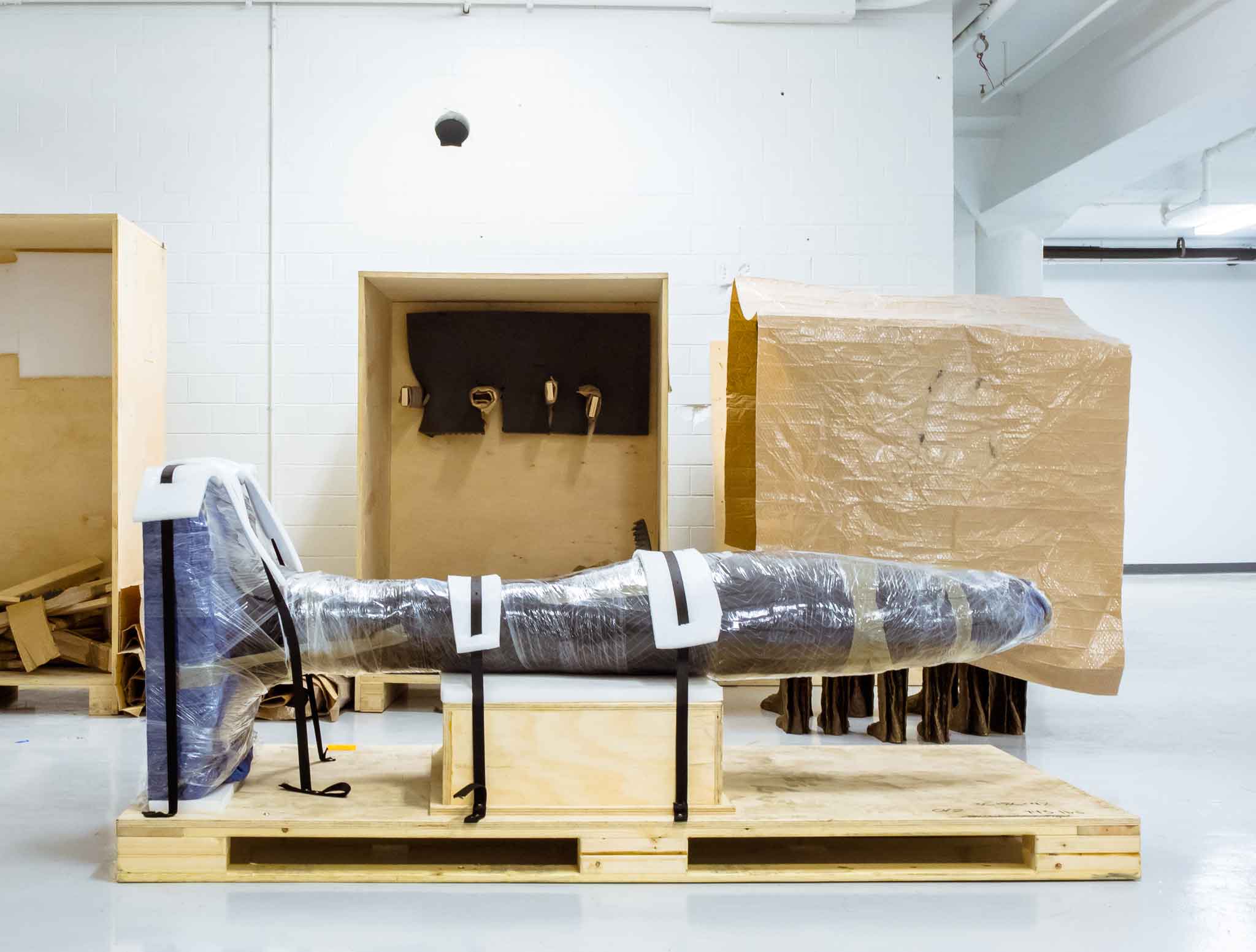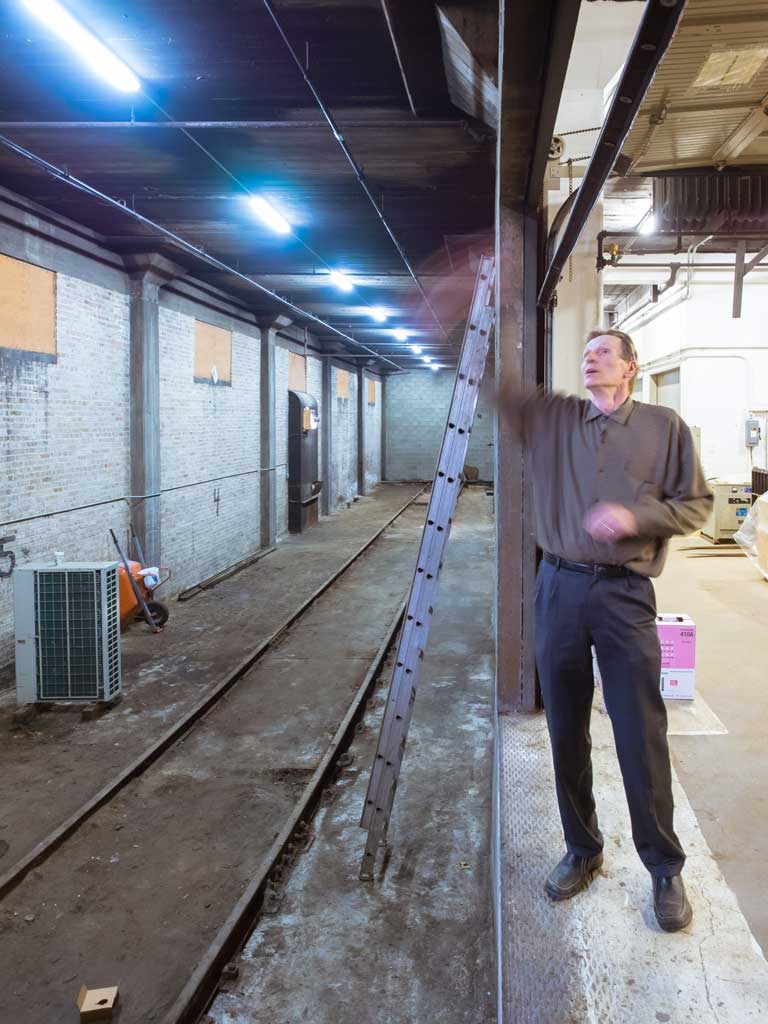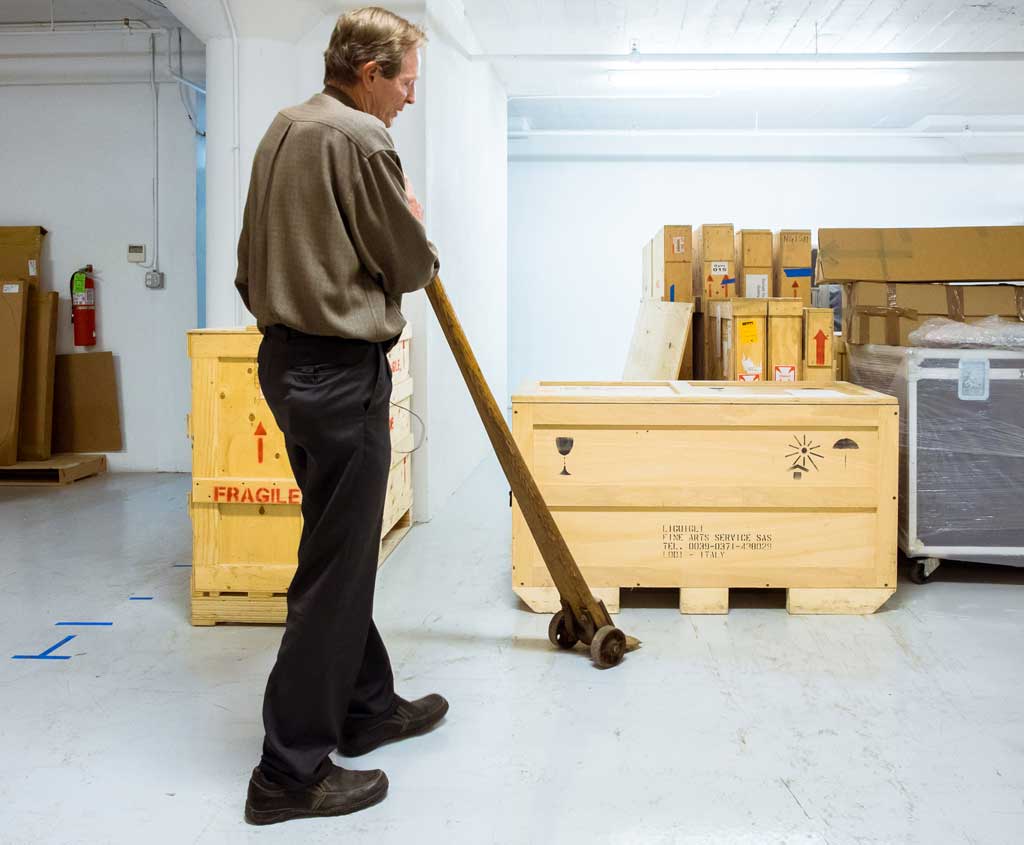When Bruce MacGilpin was working toward his Master of Fine Arts degree nearly four decades ago, his final show was an installation of ziggurat-like structures sculpted from silica sand, a rich black substance that’s discarded from the industrial casting process.
In other words, he made a collection of sand castles. They collapsed into piles of dirt after the show. But that was the point.
“Do I have to make an object that’s permanent, that sits in a museum forever?” MacGilpin says. “Or is the essence of art more about the process itself and my involvement and what I get out of it?”
Today, the former printmaker and sculptor runs a business dedicated to art’s permanence. The Icon Group Inc., the company MacGilpin cofounded in 1980, keeps art objects in pristine condition for clients such as museums, galleries, auction houses and private collectors. They rely on Icon to securely pack, move, store and install anything from oil paintings to antique furniture to large-scale works of public art. MacGilpin’s company does the heavy lifting in the most literal sense while maintaining the delicacy and discretion of an unflappable concierge.
“It’s a high-pressure field with a lot of demands in terms of time, scheduling, fragility and all that,” MacGilpin says. “And I try to keep a cool head, to teach people not to panic. … See, the customer usually is very nervous about this whole procedure, so you want to try to hold their hand (and) assure them that you’re a professional, that you know what you’re doing, that you will take great care of their object and you’re going to address all of their individual, sometimes very finicky needs.”

Icon’s moving crew once drove a collection of works by Picasso from Manhattan to Chicago without a break, because the gallery and its insurance company deemed the truck’s contents too valuable to risk any stops. Another time, MacGilpin had to get a $7 million French Impressionist painting into its buyer’s penthouse on Chicago’s Lake Shore Drive. The painting was too large to fit in the elevator and couldn’t be collapsed, so the crew hung the canvas from the bottom and sent the elevator to the top of the building.
Then there’s the “penthouse” at Icon’s storage facility, a 92,000-square foot brick-and-concrete warehouse on Chicago’s west side. The sixth and topmost floor of the building houses the archives of author, poet and illustrator Shel Silverstein. MacGilpin and his staff built out the roughly 6,500 square feet of space to the Silverstein estate’s specifications. It’s furnished with couches, rugs, an ample kitchen, a bathroom, and office equipment for the small staff that works there several days a week. A separate media room with a television set contains Silverstein’s extensive collection of vinyl records and musical instruments. Icon also installed a special early warning system on the floor. A network of thin orange pipes snakes along the ceiling, periodically sucking in air through small holes and sending it to a central chamber to be analyzed for particulate matter that might signal a fire or other problem.

Silverstein’s nephew Mitch Myers, a music journalist who also manages the archives, said the family always wanted to keep his late uncle’s materials in Chicago, where Silverstein was born and raised. The search for a location began soon after Silverstein died in 1999, and Myers says they “determined quickly there aren’t a lot of facilities prepared to handle fine arts” that could provide services beyond storage, or do a custom build-out.
The space Icon created feels more like a comfortable library than a climate-controlled storage unit. Several years ago, Myers hosted a team from New York-based Harper Collins that visited Chicago to work with the archive’s staff on “Every Thing On It,” a posthumous collection of some of Silverstein’s previously unpublished poems and drawings.
“That’s when having a space like this makes sense,” Myers says.

Providing custom amenities keeps Icon competitive against a small but well-established group of rival fine art specialists, as well as large moving and storage companies with fine art divisions. MacGilpin models his customer service style after his father, an old-fashioned doctor who made house calls at any time of day. He pushed early on to set up the company’s shuttle service between Chicago and New York, and today his trucks make interim stops in cities like Pittsburgh and Cleveland, expanding Icon’s geographic reach. Back in Chicago, one draw for customers storing their pieces at the warehouse is the facility’s viewing room, a large blank space that can be transformed into a gallery-like environment. It’s a place where clients can display their objects without taking them out of the warehouse. Art dealers can host potential buyers there, and one client once brought in a videographer to shoot a documentary about his collection.
I’ve been of the philosophy that we need to get the phone to ring. We need to provide as many services as we can. And if we get them to call and we can serve their need, then we’re ahead of the next guy.
“Some people will just do crating or storage maybe, or not do long-distance transportation,” MacGilpin says. “I’ve been of the philosophy that we need to get the phone to ring. We need to provide as many services as we can. And if we get them to call and we can serve their need, then we’re ahead of the next guy.”
Early inspiration
MacGilpin’s first foray into the industry came during graduate school at Northern Illinois University, where he helped manage a gallery program that hosted art shows. One traveling exhibition belonged to a puppeteer with a collection that included ventriloquist dummies, large Italian marionettes and shadow puppets from Thailand.
“The person who owned all these items showed up to us in Ryder rental trucks and trunks with the things just thrown in there, and I said to myself, ‘This guy needs help,’” MacGilpin recalled. He built some basic wooden crates lined with packing material for the puppet collector, and the project got him thinking about a job in services for the art industry. This path seemed more practical than teaching or making art, the most common careers for MFA graduates.
MacGilpin connected with an artist acquaintance in Chicago, who owned a step van and had just started moving art objects for a small group of clients. The two men went into business together, doing the jobs themselves, and grossed just $15,000 in their first year. In 1990, a decade after the company was founded, MacGilpin’s partner left to pursue art full-time. MacGilpin found himself running the company solo during a recession.
That period marked a turning point for the business. Early clients had had been galleries and individual collectors. Now MacGilpin realized he needed to woo museums, because they keep moving, packing and displaying art even when the broader art market declines.
“The museums are really the more stable clients, and that’s one thing I definitely learned over time: who to focus your market to so that you can survive,” MacGilpin says.
Museums may be stable clients, but they’re also demanding. They led the way in creating the modern standards for handling, packing and storing art, beginning in the 1880s. The industry bible, a 530-page handbook titled “Museum Registration Methods,” was first published in 1958. In the past decade, art custodians have looked for ways to reduce waste and switched to newer materials that don’t release potentially damaging gases. They use industrial plastic wrap, foam of different densities, bubble wrap, cardboard and quilted moving blankets.

Deciding how best to handle each object becomes its own creative exercise. “This year alone, our crew will install a Fiat on the wall, an exhibition containing sound and lighting requirements that mimic a full-on concert production, sculptures requiring cranes and rigging, and materials woven together with human hair,” Annie Breckenridge Barrett, director of collections and exhibitions at the Museum of Contemporary Art in Chicago, wrote in an email. The MCA is an Icon client.
Working with museums required MacGilpin to stop leasing ordinary trucks and invest in company-owned trucks with air suspension, climate control systems and satellite tracking. Museums also set the industry standards for storage facilities. Icon’s warehouse, where the company has operated since 2005, is a limited-access, fireproof concrete structure. It was built in the late 1920s or early 1930s for a soap- and candle-maker that received its shipments of tallow from a freight train that ran directly into the building. A confectioner took over the facility in the 1960s.
“I always joke with people that when the Armageddon comes, you want to be in this building with your whole family because it’s really built solid,” MacGilpin says. “You couldn’t duplicate it.”

Acquiring the building was a leap of faith for MacGilpin, whose previous facility was one-quarter the size. He had been planning to expand that space when Chicago Public Schools used eminent domain to take over the block, sending him scrambling for a new warehouse. His operating expenses were significantly higher in the larger building, and he had thousands of square feet of unoccupied space. Then, less than a year after the move, he got a boost from a crucial commission: Hurricane Katrina hit New Orleans, and a Chicago conservation specialist tasked with evaluating damaged artifacts needed a space for work and storage. Icon leased the company 10,000 square feet, quarantined on one floor to contain any mold or water-related problems.
A business that’s stronger than sand
While Icon’s core customers are museums needing to store or transport objects, the company gets business from a variety of sources. One large bay in the warehouse is filled with antique furniture that a Fortune 500 chief executive expected to store for six months during construction on a new house in the Chicago area. Three years later, the furniture hasn’t budged, and Icon is still collecting storage fees. Icon holds objects for clients from around the globe, including organizers of traveling exhibitions that need a way station between locations.

In recent years, with rents and insurance rates soaring in New York art districts like Chelsea, galleries there are downsizing to smaller spaces and storing pieces in Chicago with Icon, summoning items by truck when necessary. MacGilpin says monthly art storage costs can be $8 per square foot in Chelsea, compared with $1.50 at Icon. Even with the cost of transporting items between Chicago and New York, customers come out ahead.
MacGilpin’s been running Icon long enough to live through multiple economic downturns. During the latest recession, he had to furlough workers. But business has recovered, allowing him to move ahead with warehouse renovations and think about adding staff.
Icon employs about 27 people, and many of them have art backgrounds, including MacGilpin’s wife, Ingrid Fassbender, who ran her own gallery for more than a decade. The two met during the 1982 holiday season, when she was working part-time at a Chicago gallery and he was driving Icon’s vans himself. The gallery needed a shipment delivered to Michigan, and MacGilpin took the job to defray the cost of the trip to his parents’ home in Massachusetts for Christmas. When he picked up the delivery, he was so distracted by Fassbender’s charms that he left without getting the contact details for the recipient in Michigan and had to turn back.

MacGilpin and Fassbender are avid art collectors. Some of their pieces are on display at Icon, including a large photo collage in Fassbender’s office that the artist traded for free storage at the warehouse. One of MacGilpin’s pieces from art school, a rubbing of a manhole cover from 1977, hangs in the company’s break room. It came from a period where he would take a random walk and find something on the ground to rub — what he regarded as “little souvenirs of experience,” emphasizing the process over the final work.
The thing that the old timer brings to any business is the confluence of experiences that they have over time, because sometimes you learn by trial and error and by sticking your hand in the fire when you really didn’t want to.
Even so, the rubbing remains preserved for posterity at Icon’s offices. Other examples of MacGilpin’s student work, like his silica sand structures, now exist only in photographs and memories. He says it would have been “nigh impossible” for even a professional firm like Icon to transport or store those sculptures without them reverting back to dirt piles. But the process of making them was important, a lesson MacGilpin has internalized in both his artistic and business lives.
“The thing that the old timer brings to any business is the confluence of experiences that they have over time, because sometimes you learn by trial and error and by sticking your hand in the fire when you really didn’t want to,” MacGilpin says. “So it’s often a difficult, evolutionary process. … You try to capitalize on the right things and minimize the wrong ones.”